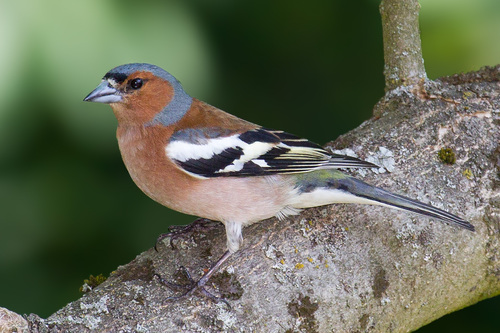
Common Chaffinch
The Common Chaffinch (*Fringilla coelebs*) is a widespread and familiar bird species found throughout Europe, North Africa, and parts of Western Asia. Known for its vibrant plumage, particularly in males, and its distinctive, ringing song, the Chaffinch plays an important ecological role as a seed disperser and insectivore. It's a highly adaptable species, thriving in a variety of habitats, from woodlands and hedgerows to parks and gardens. While not typically considered culturally significant in the same way as some iconic birds, its cheerful presence and song have made it a beloved garden visitor in many regions.
14-16 cm
Length
24.5-28.5 cm
Wingspan
Least Concern
Conservation Status
Distribution
The Common Chaffinch is found across Europe, North Africa (Morocco, Algeria, Tunisia), and western Asia, including Turkey, Iran, and parts of the Middle East. Some populations are migratory, moving south for the winter, while others are resident year-round. They have an altitudinal range from sea level to mountain forests, depending on the region.
Lifespan
Typically 3 years in the wild, but can live longer (up to 14 years recorded).
Common Chaffinch's Habitat
Habitat Types
Woodlands, Hedgerows, Parks, Gardens, Farmland, Orchards
Climate Zones
Temperate, Mediterranean, Boreal
Adaptations
Chaffinches exhibit generalist adaptations, allowing them to thrive in diverse environments. Their strong beaks are well-suited for cracking seeds, a primary food source, but they also readily consume insects, particularly during the breeding season. Their ability to utilize a wide range of food resources contributes to their success in various habitats.
Variations
Several subspecies of *Fringilla coelebs* are recognized, differing subtly in plumage coloration and size. For example, North African subspecies tend to have brighter blue-grey crowns than their European counterparts. Island populations, such as those in the Canary Islands, often show distinct morphological differences.
Appearance
Breeding Plumage
Males have a distinctive blue-grey cap, rusty-pink breast and face, and black and white wing bars during the breeding season. Females are duller, with a more olive-brown and grey plumage. In non-breeding plumage, males become less vibrant, resembling females more closely.
Seasonal Feather Changes
The intensity of the male's breeding plumage fades after the breeding season. Molting occurs in late summer.
Sex Based Plumage Differences
Strong sexual dimorphism, particularly in breeding plumage. Males are brightly colored, while females are more cryptic.
Notable Features
White wing bars (prominent in flight), White outer tail feathers, Conical bill (typical of finches)
Diet and Feeding
Primary Foods
Seeds, Insects, Caterpillars, Berries
Foraging Behavior
Chaffinches forage on the ground, often hopping and pecking for seeds and insects. They also glean insects from foliage and occasionally take berries. They are often seen at bird feeders, particularly during winter.
Specializations
Their strong, conical bill is well-adapted for cracking open seeds of various sizes. While not highly specialized, their beak shape allows for efficient seed handling.
Seasonal Diet Variations
Diet shifts seasonally. Insects and caterpillars are a crucial part of the diet during the breeding season, providing protein for growing chicks. Seeds form the bulk of the diet during the non-breeding season.
Behavior
Social Structure
Chaffinches are generally gregarious outside of the breeding season, often forming large flocks, sometimes mixed with other finch species. During the breeding season, they become territorial.
Communication
Loud, ringing song (used for territorial defense and mate attraction), Variety of calls (including contact calls and alarm calls), Visual displays (wing-fluttering, chasing)
Migration
Some populations are migratory, undertaking long-distance movements between breeding and wintering grounds. Others are resident or only partially migratory. Migration patterns vary depending on geographic location and food availability. Northern European populations tend to be more migratory than southern ones.
Territorial or Group Behaviors
Males are territorial during the breeding season, defending their chosen nesting area from rivals. Outside of the breeding season, they form flocks, often foraging together.
Conservation
Threats
Habitat loss (due to deforestation and agricultural intensification), Pesticide use (reducing insect prey availability), Climate change (potential impacts on breeding success and migration patterns)
Protection Programs
General wildlife protection laws in many countries, Habitat restoration and management initiatives, Monitoring programs (e.g., bird surveys)
Local National Laws
Protected under various national and international wildlife legislation, such as the EU Birds Directive.
Population Trend
Stable
Population Estimates
The global population is estimated to be in the hundreds of millions.
Interesting Facts
The scientific name 'coelebs' means 'unmarried' or 'bachelor'.
Linnaeus gave this name because, in Sweden, he observed mostly male Chaffinches during winter, as females often migrate further south.
Chaffinches have regional 'dialects' in their songs.
The song structure can vary significantly between different geographic areas.
They can be quite bold and readily approach bird feeders.
This makes them a popular garden bird in many areas.
Faqs about Common Chaffinch
What do Chaffinches eat?
Chaffinches eat a mix of seeds and insects. They feed their chicks primarily insects during the breeding season, and switch to a more seed-based diet in winter.
Where do Chaffinches build their nests?
Chaffinches build cup-shaped nests in trees or bushes, often well-concealed amongst foliage.
Are Chaffinches migratory?
Some Chaffinch populations are migratory, while others are resident. Migration patterns vary depending on location.
How can I tell the difference between a male and female Chaffinch?
Male Chaffinches have a blue-grey cap and a rusty-pink breast, while females are a duller olive-brown and grey.
Copyright @ Nature Style Limited. All Rights Reserved.
 English
English